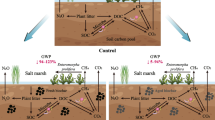Abstract
Temperature dependence and seasonal variations in rates of microbial degradation of the lignin and polysaccharide components of specifically radiolabeled lignocelluloses were determined in sediment and water samples from a Georgia salt marsh and the nearby Okefenokee Swamp. Although temperature regimes in the two ecosystems were similar, rates of mineralization ofSpartina alterniflora lignocellulose in salt marsh sediments increased eightfold between winter and summer, whereas rates of mineralization of lignocellulose from an analogous freshwater macrophyte,Carex walteriana, in Okefenokee sediments increased only twofold between winter and summer. Temperature was the major factor influencing seasonal variations in rates of lignocellulose degradation in both environments. At any given temperature, no substantial differences in lignocellulolytic potential were observed with sediment samples collected at each season. In both ecosystems, the bulk of the lignocellulosic detritus was not degraded at the time of its peak deposition during the fall and winter. Instead, the periods of maximal decomposition occurred during the following spring and summer. These results suggest that periods of maximal nutrient regeneration from the mineralization of lignocellulosic detritus coincide with periods of highest primary production, and that, depending on hydrologic conditions, significant horizontal transport of essentially intact lignocellulosic material is possible due to the lag period between deposition and microbial degradation.
Similar content being viewed by others
References
Benner R, Maccubbin AE, Hodson RE (1984) Preparation, characterization, and microbial degradation of specifically radiolabeled [14C]lignocelluloses from marine and freshwater macrophytes. Appl Environ Microbiol 47:381–389
Benner R, Maccubbin AE, Hodson RE (1984) Anaerobic biodegradation of the lignin and polysaccharide components of lignocellulose and synthetic lignin by sediment microflora. Appl Environ Microbiol 47:998–1004
Benner R, Moran MA, Hodson RE (1985) Effects of pH and plant source on lignocellulose biodegradation rates in two wetland ecosystems, the Okefenokee Swamp and a Georgia salt marsh. Limnol Oceanogr 30:489–499
Benner R, Moran MA, Hodson RE (1985) Biogeochemical cycling of lignocellulosic carbon in marine and freshwater ecosystems: relative contributions of procaryotes and eucaryotes. Limnol Oceanogr 31:89–100
Benner R, Newell SY, Maccubbin AE, Hodson RE (1984) Relative contributions of bacteria and fungi to rates of degradation of lignocellulosic detritus in salt marsh sediments. Appl Environ Microbiol 48:36–40
Brinson MM (1977) Decomposition and nutrient exchange of litter in an alluvial swamp forest. Ecology 58:601–609
Brinson MM, Lugo AE, Brown S (1981) Primary productivity, decomposition and consumer activity in freshwater wetlands. Ann Rev Ecol Syst 12:123–161
Gardner WS, Menzel DW (1974) Phenolic aldehydes as indicators of terrestrially-derived organic matter in the sea. Geochim Cosmochim Acta 38:813–822
Hodson RE, Benner R, Maccubbin AE (1983) Transformations and fate of lignocellulosic detritus in marine environments. In: Oxley TA, Barry S (eds) Biodeterioration 5. John Wiley & Sons Publishers, New York, pp 185–195
Hodson RE, Christian RR, Maccubbin AE (1984) Lignocellulose and lignin in the salt marsh grass,Spartina alterniflora: initial concentrations and short-term post-depositional changes in detrital material. Mar Biol 81:1–7
Hyatt RA, Brook GA (1984) Ground water flow in the Okefenokee Swamp and hydrologie and nutrient budgets for the period August 1981 through July 1982. In: Cohen AD, Casagrande DJ, Andrejko MJ, Best GR (eds) The Okefenokee Swamp: its natural history, geology, and geochemistry. Wetlands Surveys, New Mexico, pp 229–245
Maccubbin AE, Hodson RE (1980) Microbial degradation of detrital lignocelluloses by salt marsh sediment microflora. Appl Environ Microbiol 40:735–740
Mann KH (1972) Macrophyte production and detritus food chains in coastal waters. Mem Ist Ital Idrobiol 29 (Suppl):353–383
Montagna PA, Ruber E (1980) Decomposition ofSpartina alterniflora in different seasons and habitats of a northern Massachusetts salt marsh, and a comparison with other Atlantic regions. Estuaries 3:61–64
Odum EP, de la Cruz AA (1967) Paniculate organic detritus in a Georgia salt marsh-estuarine ecosystem. In: Lauff GH (ed) Estuaries. Am Assoc Adv Sci, Washington, DC, pp 383–388
Schubauer JP, Hopkinson CS (1984) Above- and below-ground emergent macrophyte production and turnover in a coastal marsh ecosystem, Georgia. Limnol Oceanogr 29:1052–1065
Teal JM (1962) Energy flow in the salt marsh ecosystem of Georgia. Ecology 43:614–624
Valiela I, Wilson J, Buchsbam R, Rietsma C, Bryant D, Foreman K, Teal J (1984) Importance of chemical composition of salt marsh litter on decay rates and feeding by detritivores. Bull Mar Sci 35:261–269
Author information
Authors and Affiliations
Rights and permissions
About this article
Cite this article
Benner, R., Maccubbin, A.E. & Hodson, R.E. Temporal relationship between the deposition and microbial degradation of lignocellulosic detritus in a Georgia salt marsh and the Okefenokee Swamp. Microb Ecol 12, 291–298 (1986). https://doi.org/10.1007/BF02011172
Issue Date:
DOI: https://doi.org/10.1007/BF02011172




